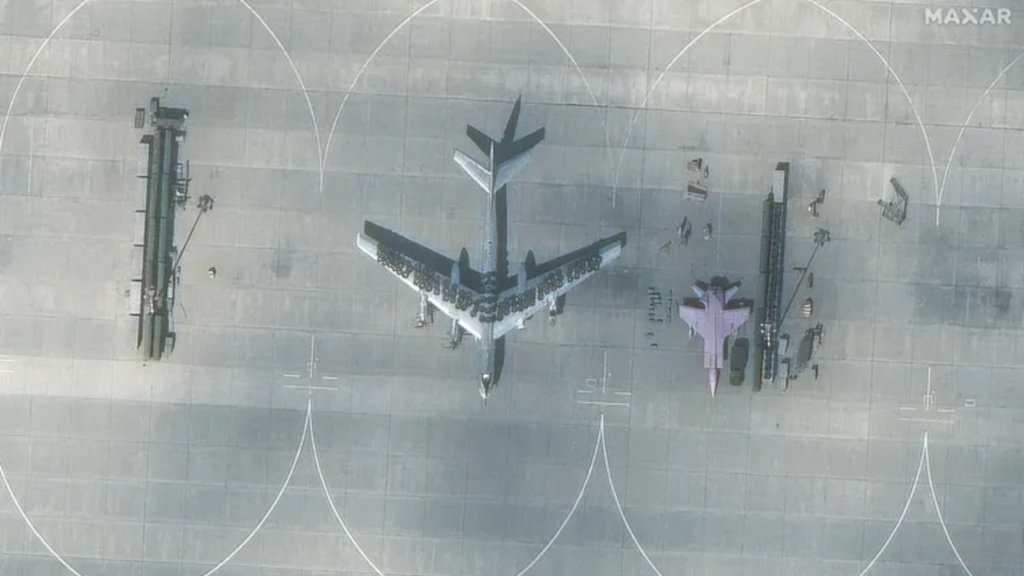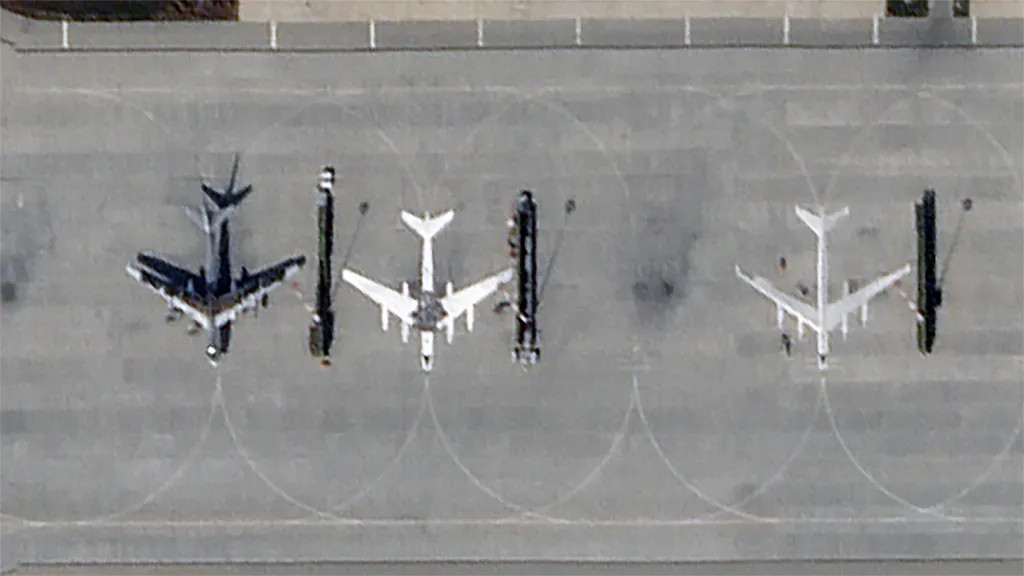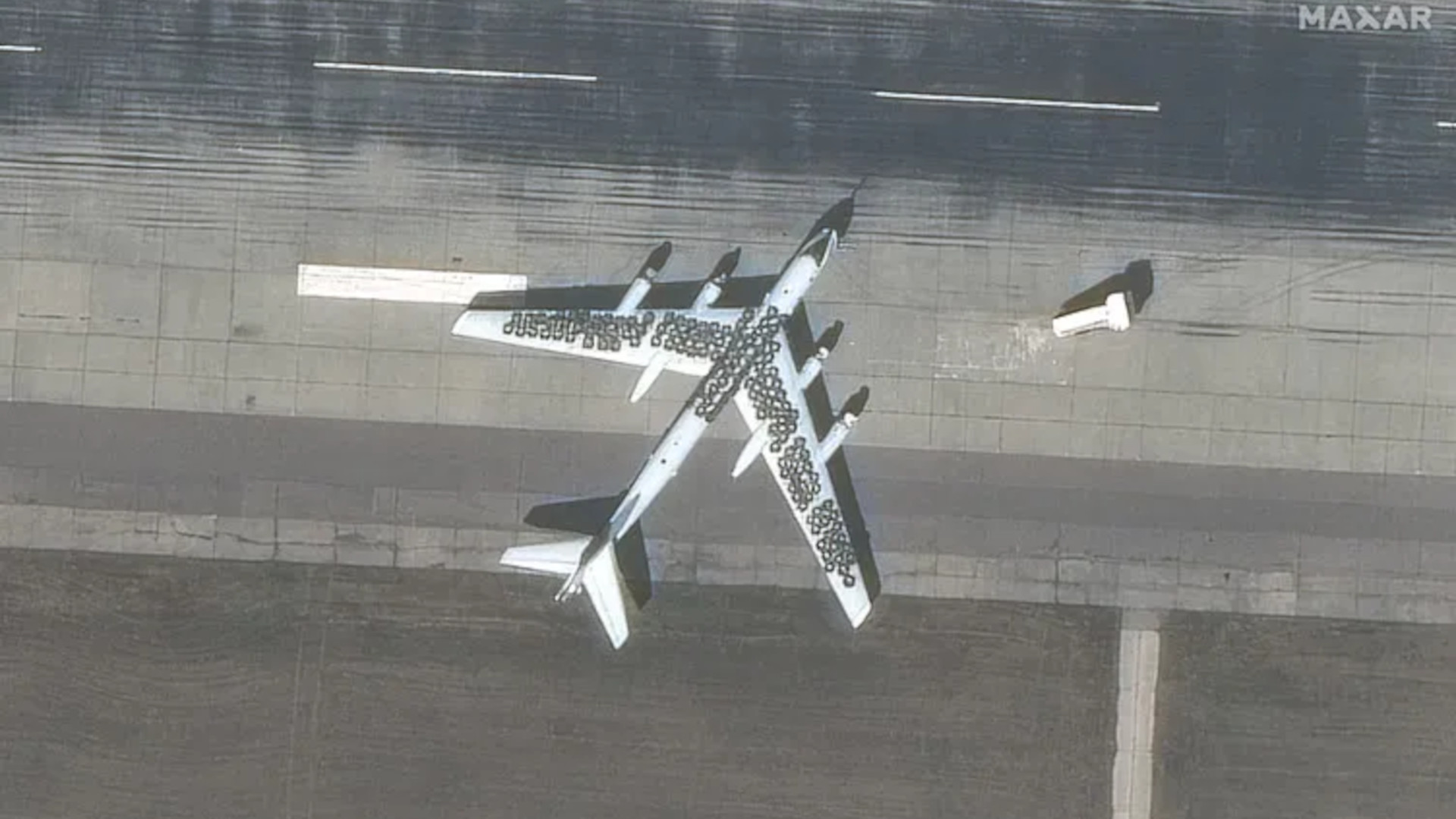Russia putting tires on top of bombers and other aircraft was about confusing seekers with image-matching capability on incoming munitions, a senior U.S. military technologist has confirmed. This is exactly what The War Zone said was the most likely explanation for the tactic when it first emerged last year.

Schuyler Moore, U.S. Central Command’s (CENTCOM) first-ever Chief Technology Officer, mentioned the Russian use of tires to disrupt incoming attacks on air bases during a broader live-streamed roundtable talk on artificial intelligence (AI) and related technologies that the Center for Strategic & International Studies (CSIS) think tank hosted today. Before taking up her current role, Moore had been Chief Strategy Officer for U.S. Naval Forces Central Command’s (NAVCENT) Task Force 59, which is tasked with experimenting with integrating new AI-driven and uncrewed capabilities into day-to-day naval operations in the Middle East.
A “sort of classic unclassified example that exists is like a picture of a plane from the top, and you’re looking for a plane, and then if you put tires on top of the wings, all of a sudden, a lot of computer vision models have difficulty identifying that that’s a plane,” Moore said as part of a larger discussion about AI models and data sets.
Russia was first observed using tires to help shield Tu-95 and Tu-160 bombers at the Engels-2 Air Base from attack in the fall of 2023. This followed numerous Ukrainian long-range kamikaze drone attacks on the base, which is situated some 300 miles from the border with Ukraine. Images of other types of Russian aircraft covered with tires subsequently emerged.


At around the same time, it also emerged that Ukrainian forces had begun using a land-attack variant of the domestically developed Neptune ground-launched anti-ship cruise missile said to use an infrared imaging seeker. Before then, Ukraine’s Air Force had also begun receiving virtually identical Storm Shadow and SCALP-EG air-launched cruise missiles, which also use imaging infrared seekers to find their targets in the terminal stages of flight.
While some suggested the tires could provide some degree of added physical protection against drones and other threats, The War Zone laid out a detailed case that the tactic most likely had to do with befuddling image-matching seekers on incoming munitions. Seekers of this kind are immune to radiofrequency electronic warfare jamming and also scan for potential targets to check against their pre-loaded data library passively making weapons equipped with them harder to detect in the first place. Other AI-driven targeting capabilities are now also starting to emerge on the battlefield in Ukraine. These are likely to keep proliferating, and on far less complex platforms that can be deployed en masse, as The War Zone has previously explored in detail.
CENTCOM’s Moore brought up the tire tactics as an example of why AI-driven targeting systems need to use models and data sets that are readily ‘accessible’ in various ways to users as close as possible to the tactical edge to be truly effective going forward.
“We’re not saying that we need to have our own internal AI development team. What we need is for our users to better be able to engage with the models that exist out there,” she explained. “So that means that they need to be able to label new data sets that they think are relevant to them. They need to be able to push those labeled data sets to then retrain a model to look for something different.”
“If you were able, in that single moment for a user to say, I identified that the adversary has changed what they are doing visually [with the tires], I am going to go back and start labeling to at least adjust for maybe I’m looking for a different type of plane shape, or I’m looking for a nuance that accounts for a change in coloration on top of the wings, that may be able to get me there,” she continued. “But if it takes you six months to get to that answer, and then the next day, they said ‘Oh, perfect. You didn’t like tires? Okay, I’ll put something else on top,’ and it breaks the model … again, we are spending inordinate amounts of time on computer vision with very little to gain.”
Moore’s mention of “coloration” here is also notable. Though she did not reference it directly, Russia has also been painting silhouettes of aircraft on the tarmac at air bases, again most likely to try to confuse imaging seekers and lure them away from real targets. There is at least one example of a submarine silhouette (which also had a fake sail structure) appearing at a Russian naval base for what is very likely the same reason. Last year, some surface warships in Russia’s Black Sea fleet also began sporting new paint jobs that seemed similarly intentioned.

Russia has also employed other kinds of physical decoys to try to draw enemy fire in the ongoing conflict, though Ukraine has so far been more prolific when it comes to this kind of deception.
As CENTCOM’s Moore made clear today, the observations from Ukraine are relevant for the U.S. military, and not just when it comes to targeting enemy forces in the future using AI-driven capabilities. America’s armed forces are currently focused primarily on preparing for future high-end fights, especially a potential one against China in the Pacific. As a result, there has been a notable resurgence of interest in camouflage, concealment, and deception capacities and tactics in the face of significantly growing Chinese intelligence, surveillance, and reconnaissance (ISR) capabilities, particularly in space. AI has already progressed to the point where it is being used to help find objects of interest in publicly available commercial satellite imagery.
“Today, the adversary has migrated to kill webs that fully integrate multiple sensors [and] multiple ‘bullets’ [kinetic and non-kinetic effects] … against multiple simultaneous targets, all fully networked together … and all talking together through multiple communication paths,” U.S. Space Force Gen. Michael Guetlein, Vice Chief of Space Operations, said at the 2024 Defense News Conference just last week. “Unfortunately, the adversary is capable of using these kill webs to hold our joint forces at risk across great distances, across multiple domains, and with persistence. This is a very sophisticated and challenging threat.”
“We have to be very sophisticated in our decoys, if you will,” Gen. David Allvin, Chief of Staff of the Air Force also said at another live-streamed talk at the Hudson Institute think tank back in August. “I mean, you can’t just put [up] an inflatable F-35 and say, ‘Guess what? Everybody’s gonna think it’s an F-35.’”
“When you think of how advanced algorithms are, you need to be pretty sophisticated, otherwise that money will be worthless because the adversary will go, they’ll discount it immediately,” Allvin continued. “How do you mimic pattern of life? How do you mimic a signature? And so we’re looking at all those ways to ensure that the things that we are doing are actually appropriate for the time.”
It seems unlikely that American military aircraft will emerge covered in tires any time soon. At the same time, that Russian tactic, now confirmed to have been about confusing imaging seekers, reflects real issues that go well beyond the conflict in Ukraine.
Contact the author: joe@twz.com
